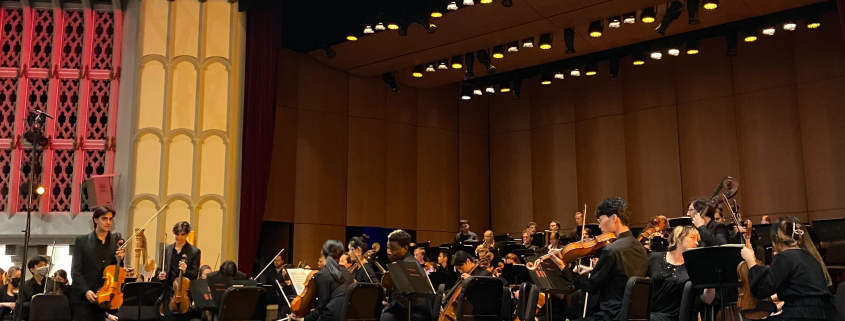USC Thornton Symphony blows Bovard away

Guests were welcomed into a dimly-lit Bovard Auditorium as a lively crowd thrummed with excitement and anticipation for the USC Thornton Symphony’s opening concert Friday.
With just one look at the Sept. 9 program, it is easy to see why the symphony’s first concert had an exceptional turnout — including stand out suites like “Daphnis et Chloé, Suite No. 2” by Maurice Ravel and “Pictures at an Exhibition” by Modest Mussorgsky.
The evening started off strong as guests were greeted immediately with a sleepy, fairytale-like introduction from the woodwind section and lower strings. Before the audience became aware, multiple layers of moving lines were added on top of the slow accompaniment with a whirlwind of sounds within the symphony. Just as quickly as it was introduced, the heavy layers dissipated and focused onto the shimmering flute and clarinet soloists, Lindsay Bryden and Ray Wyant.
While the soloists remained focused, they were continually supported by the entire strings section who littered the background with beautiful, emotional swells. Seamlessly, the strings took the foreground and delivered multiple mini-build ups that eventually climaxed to the audience right around the third minute as the music subtly transitioned into a quicker-paced, more dramatic theme.
The symphony entered a more sparsely orchestrated part led by the haunting and repetitive oboe line, which quickly lended itself to a shy woodwind and string interlude in the sixth minute. Surprisingly, this initially dense movement closed with a final, unsure-sounding clarinet solo. The second movement, “Pantomime,” was consumed by an elegant flute solo which challenged its unsure beginnings; the solo dominated the score, and impressively, the clean flute runs established a rather mischievous theme for the midsection. “Pantomime” finished off with romantic, symphony-wide chords before it abruptly began the chaotic-sounding “Danse générale.”
After the initial plunge into the third and final movement, the music rapidly descended into a tragic-sounding theme before it quickly snapped the audience into a fast-paced march, marked by insane runs in the greater woodwind section and a militant-sounding accompaniment in the brass, lower strings and percussion. In a dizzying change of pace, “Danse générale” could not have been more different than its two predecessors — a hectic movement delineated by amazing dynamic control, exhilarating themes, and overall incredible musicianship; this is exactly what live classical music is about.
“Promenade 1” opened with a confident and gallant trumpet solo by principal player on the piece, Ben Gunnarson. In a call and response pattern, the soloist’s phrase was echoed by the rest of the brass and lower strings/woodwinds, and then combined into the gentle melodies of the string section.
Just as one settled into the primary motif, the lower strings did an impressive job of blindsiding the audience by introducing the deeply unsettling phrase that stalks this movement throughout. Continuing with the heaviness that was previously established, somehow the music became darker, and the symphony succeeded in delivering a sense of uneasiness and edge with the strings chromatically slinking downward while the brass reinforced the eerie melody.
“Promenade 2” started with a solo by Sussannah Greenslit, principal french horn player on the Mussorgsky. She played a lovely reprise of the original trumpet solo as she was echoed by light orchestration in the woodwinds. A calmer air settled on the symphony, as this movement, titled “The Old Castle,” was characterized by a sound that can only be described as antique.
In “Tuileries,’’ the symphony began a cheery uptick in tempo and range that primarily took place in the upper register of the woodwind and string sections. However, this brief interlude was succeeded by a positively glowing solo by euphonium player Arisa Makita in “Bydło.” In a clear and commanding performance, Makita’s solo provided passage to the forthcoming free, rolling string melodies.
What was most enjoyable about the last movements was certainly how eccentric each one was in its own right, from “Limoges,” the fast and technically-exhausting favorite, to “Catacombs,” where the brass section was devastatingly intense. However, nothing can beat the ninth and tenth movements, “The Hut on Fowl’s Legs” and “The Great Gate of Kiev” — an all-encompassing and fitting ending. With enormous runs that swept through the symphony along with a fully-realized rendition of the theme, they were nothing short of a truly glorious suite.
The musicians were met with a rousing — and seemingly endless — standing ovation that conveyed a job well done; following recognition of the soloists, conductor Carl St. Clair thanked the audience for their attendance and encouraged them to consider future Thornton concerts. Stepping out into the light showers of the evening, a collective sense of contentment and a night well-spent fell over attendees, as they exited Bovard Auditorium after an excellent opening performance.

